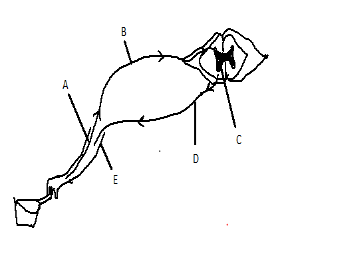
Label the parts A,B,C, D,E and give a proper title to the diagram.


Answer
546.3k+ views
Hint: In response to a stimulus, a reflex, or reflex movement, is an automatic and almost spontaneous motion. A reflex is made possible by neural mechanisms called reflex arcs that may act on an impulse before the brain hits that impulse. The reflex is therefore an unconscious reaction to a stimulus that does not undergo conscious thinking or requires it.
Complete answer:
A cortical pathway that controls a reflex is a reflex arc. Many sensory neurons do not move immediately through the brain of vertebrates, but synapse across the spinal cord. This encourages quicker reflex acts to occur without the interruption of routing impulses through the brain by triggering spinal motor neurons.
A- receptor
B-sensory neuron
C- Association neuron
D-Motor neuron
E- effector
If only one sensory neuron and one motor neuron consist of a reflex arc in an animal, it is known as monosynaptic, referring to the involvement of a single chemical synapse. In the case of peripheral muscle reflexes (patellar reflex), fast muscle spindle stimulation results in the relaxation of the muscle of the agonist or effector. In comparison, one or more interneurons connect afferent (sensory) and efferent (motor) signals in polysynaptic reflex pathways.
Note: When touching the patellar tendon just below the knee, is a specialized system known as a muscle spindle situated inside the quadriceps, the tap initiates an action potential. The ability for this action passes via a sensory axon to the L3 and L4 nerve roots of the spinal cord, which chemically interacts by releasing glutamate to the motor nerve. Contraction of the quadriceps muscle is the result of this motor nerve operation, resulting in an extension of the lower leg at the knee.
Complete answer:
A cortical pathway that controls a reflex is a reflex arc. Many sensory neurons do not move immediately through the brain of vertebrates, but synapse across the spinal cord. This encourages quicker reflex acts to occur without the interruption of routing impulses through the brain by triggering spinal motor neurons.
A- receptor
B-sensory neuron
C- Association neuron
D-Motor neuron
E- effector
If only one sensory neuron and one motor neuron consist of a reflex arc in an animal, it is known as monosynaptic, referring to the involvement of a single chemical synapse. In the case of peripheral muscle reflexes (patellar reflex), fast muscle spindle stimulation results in the relaxation of the muscle of the agonist or effector. In comparison, one or more interneurons connect afferent (sensory) and efferent (motor) signals in polysynaptic reflex pathways.
Note: When touching the patellar tendon just below the knee, is a specialized system known as a muscle spindle situated inside the quadriceps, the tap initiates an action potential. The ability for this action passes via a sensory axon to the L3 and L4 nerve roots of the spinal cord, which chemically interacts by releasing glutamate to the motor nerve. Contraction of the quadriceps muscle is the result of this motor nerve operation, resulting in an extension of the lower leg at the knee.
Recently Updated Pages
Why are manures considered better than fertilizers class 11 biology CBSE

Find the coordinates of the midpoint of the line segment class 11 maths CBSE

Distinguish between static friction limiting friction class 11 physics CBSE

The Chairman of the constituent Assembly was A Jawaharlal class 11 social science CBSE

The first National Commission on Labour NCL submitted class 11 social science CBSE

Number of all subshell of n + l 7 is A 4 B 5 C 6 D class 11 chemistry CBSE

Trending doubts
Differentiate between an exothermic and an endothermic class 11 chemistry CBSE

10 examples of friction in our daily life

One Metric ton is equal to kg A 10000 B 1000 C 100 class 11 physics CBSE

Difference Between Prokaryotic Cells and Eukaryotic Cells

1 Quintal is equal to a 110 kg b 10 kg c 100kg d 1000 class 11 physics CBSE

State the laws of reflection of light




